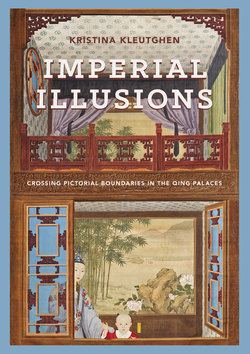Читать книгу Imperial Illusions - Kristina Kleutghen - Страница 25
На сайте Литреса книга снята с продажи.
Оглавлениеdirectly engage the viewer, provide the nexus between the viewer’s tangible body and the intangible sense of sight, personally drawing the viewer forward into the depicted world. Seventeenth- and eighteenth-century comments, as well as the literary record, indicate that touch was often responsible for a viewer’s recognition of what he saw as a painting: viewers did not understand a seemingly permeable space to be a wall-mounted illusionistic painting until they touched it, or even accidentally bumped into it. The same visual depth cues in the painting that drew viewers forward to touch the objects depicted, however, also moved them inexorably toward the discovery of the painting’s materiality and the collapse of the illusion.
Touch was always only a means to an end, however. Whether by intellectual recognition or haptic connection, scenic illusions were always discovered as paintings and were enjoyed as such, even though all their features initially conspired to conceal that identity. Their deceptions were extended by the perfect viewing position prescribed by both linear perspective and the surrounding architecture, which directed the viewer into place. But the illusion always disintegrated in the end, thereby giving rise to the moment of recognition necessary to the disjunction between first seeing the scene and then understanding that it was a painting. The goal of illusionistic painting in general is not permanent deception (which is impossible), but instead astonishment or amazement at one’s own misperception.37 Illusionistic paintings “lose their raison d’être” without the viewer’s willing complicity in balancing his or her perception of real space with the acknowledgment of a mere flat painted surface.38 That Qianlong repeatedly commissioned and engaged with views that he knew to be only paintings demonstrates just how enjoyable he found both visual illusions and these paintings in particular.
The Necessity of Space and Place
As paintings intended to decorate (rather than visually replace) their supporting walls, ordinary affixed hangings were typically much smaller than the walls and were displayed continuously for long periods of time. Sometimes they were removed and replaced with other paintings, moved to other locations to decorate those spaces, or remounted as scrolls, as the small version of Spring’s Peaceful Message was some time after being removed from the Hall of Mental Cultivation.39 Using a monumental wall-encompassing version of the affixed hanging format for scenic illusions theoretically implies that one could move them from one wall to another, as long as the dimensions were the same. However, the paintings were tailored precisely to the size and form of the structure, down to its distinctive decorative features. Removing or dissociating scenic illusions from their original locations therefore destroys their original effects. Nevertheless, their physical features still suggest something of the original settings, even if those have been lost. Composed and fitted to cover the entire area of the supporting surface, untrimmed paintings suggest the original size of that surface, and the placement of apertures in an unmounted
